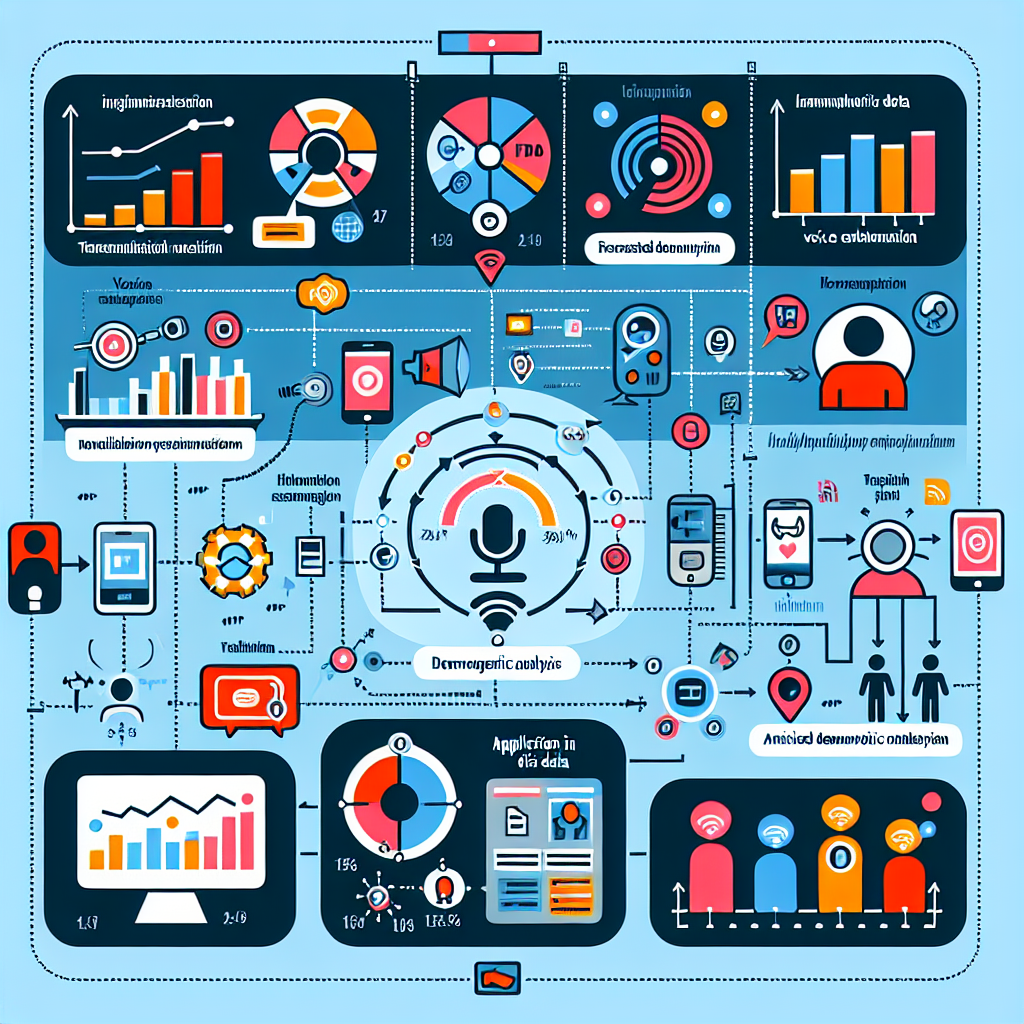
In the realm of advanced technology tools, voice analysis technology has garnered significant attention in the marketing realm. This technology enables a deepened understanding of the customer profile by analyzing voice attributes retrieved during interactions. Now, businesses can be better equipped to comprehend their target demographics, fostering more tailored service delivery. One of the remarkable applications of this technology is voice-based demographic analysis, specifically for predicting and understanding age and gender demographics.

At a fundamental level, voice characteristics vary greatly both by age and gender. Thus, the analysis of voice attributes can indicate the age and gender of the speaker with a proficient degree of accuracy. This information, when correctly interpreted, can be a valuable asset in developing the strategic marketing initiatives catered to a specific demographic.
Implementing voice-based demographic analysis can lead to more personalised marketing campaigns, enabling businesses to tailor their products and services to the target demographic. For example, product recommendations can be modified to align with the age group and gender of the customer. This level of customization can result in increased customer engagement, loyalty, and ultimately business growth.
Although this technology is still emerging, many businesses are beginning to understand its potential benefits. With the incorporation of artificial intelligence (AI), machine learning (ML), and big data analytics, voice-based demographic analysis is poised to revolutionize how businesses understand their customer demographics and inform marketing insights.
Briefly put, voice-based demographic analysis could revolutionize market segmentation strategies, providing real-time, high-value marketing insights. As technology continues to evolve, the scope and accuracy of these tools will likely only increase, solidifying their standing as an essential tool for companies aiming to get the most out of their customer interactions.
Increasingly, businesses are utilizing advanced technologies such as Artificial Intelligence (AI) and Machine Learning (ML) models in order to garner critical customer information. Most notably, voice-based age and gender analysis, capable of unearthing invaluable marketing insights. These models not only offer a more personalized customer interaction experience, but also assist businesses to shape targeted marketing stratagems.
Forming the foundation of this process, signal processing techniques are employed to extract vocal attributes. These vocal characteristics are then analyzed by machine learning algorithms, culminating in the identification of the speaker's age and gender. Signal processing, is, therefore, a critical element in voice-based analysis, enhancing the reliability of the insights drawn.
Further advancements in these technologies now facilitate nuanced understanding of vocal attributes with deep learning. Deep learning models, using large volume data sets, identify subtle variances, enhancing the accuracy of age and gender prediction. Customer interaction platforms such as automated chatbots, interactive voice response systems and customer service robots are able to leverage these technologies in order to gain more profound understanding of their users.
Incorporating these insights into their strategies, businesses can develop targeted marketing campaigns adjusted to the correct demographic, guaranteeing more effective results. For instance, a business can track their customer's voice data for real time age and gender identification, then tailor their product suggestions to match the user's profile. The use of voice-based age and gender analysis thus offers businesses a strategic upper hand, delivering bespoke solutions for their consumers.
In conclusion, the integration of AI and ML technologies, especially in the field of voice-based age and gender analysis, is not a mere boon; it's now an imperative in the contemporary marketing landscape. By acquiring comprehensive insights, businesses can ensure they deliver personalized customer experiences, fostering successful and enduring relationships.
In the modern era of digital marketing, leveraging the potential of voice-based age and gender analysis is critical for targeted advertising and customer engagement. Understanding the demographics of consumers such as age and gender promotes specificity in marketing strategies, allowing for precise ad campaigns that resonate with the intended audience. Technology has indeed paved the way for such in-depth customer analysis, and it is up to marketers to harness it.

For example, having data on the age group that interacts most with a product could help a business strategically tailor messages to evoke the interests of this group. Similarly, gender-specific data facilitates the creation of marketing content with a personal touch. Communicating with male and female audiences effectively requires vastly different approaches, making this data indispensable for boosting customer engagement and sales.
Moreover, understanding age and gender demographics plays a significant role in optimizing media buying. Deploying ads to platforms frequented by the target age and gender enhances the probability of sales conversions. This level of precision eliminates guesswork, leading to efficient resource allocation and better ROI. Indeed, voice-based age and gender analysis is indeed a marketer’s treasure trove for customer engagement and targeted advertising.
Furthermore, these metrics are key to driving personalization in marketing. The modern customer desires products and services that cater directly to their needs. Age-specific and gender-specific communication makes them feel valued, appreciated, and understood, which achieves a higher level of responsiveness and loyalty.
Blend the science of voice-based age and gender analysis with the art of marketing, and your business stands to gain tremendously in terms of customer engagement, conversion rates, and ROI.
The advent of voice-based age and gender analysis has brought about remarkable advancements in the creation and execution of targeted marketing campaigns. While this technology can be, and indeed is, a powerful tool, it’s essential to consider the ethical dimensions attached to its application in marketing. Notably, these spheres cover areas such as privacy and the potential for bias.
In regard to privacy concerns, companies using voice analysis technology must strictly adhere to the various guidelines and legislations pertaining to data privacy, for example, the General Data Protection Regulation (GDPR) in Europe or the California Consumer Privacy Act (CCPA) in the United States. Auto-recording and analyzing customer's voices without their explicit consent violates their privacy. It is thus pivotal for any company to ensure they prioritize transparency by adequately informing their customers about the data collection process, its purpose, and safeguards put in place.
Besides privacy, this sort of technology may yield biased results, which raises another important ethical question. If not precisely calibrated, voice analysis algorithms can reflect intrinsic societal biases, potentially leading to marketing insights that are skewed or even discriminatory. To mitigate this, companies should actively work towards developing and training their algorithms on diverse and inclusive voice datasets. This would help to reduce the chance of potential bias and ensure a fair marketing strategy.
In conclusion, the responsible utilization of voice analysis technology in marketing insights necessitates strict adherence to privacy guidelines, rigorous transparency in information communication, and continuous efforts to minimize bias. This is a fast-evolving domain that more research is needed to fully comprehend and navigate its ethical implications.
In an increasingly data-driven marketing sphere, understanding customers and their preferences has never been more essential. Two industries spearheading the implementation of voice-based demographic analysis, such as age and gender identification, are telecommunication services and retail e-commerce. Explicating the success stories in both sectors can provide insightful lessons.

Telecommunication providers are utilizing voice-based demographic intelligence to tailor their services better. Calls made to customer service centers provide a data gold mine. By analyzing the customer's age and gender, companies can customize their service offerings and even direct the customer to an agent who is likely to resonate most. This personalized response not only boosts customer satisfaction but also drives customer loyalty, giving companies a competitive edge.
In the retail e-commerce sphere, the use of voice search has grown exponentially with the emergence of digital personal assistants. Businesses can analyze these voice searches to gain insights into the age group and gender of their online shopper demographics. Retailers can thereby tailor their marketing campaigns and product offerings to better align with shopper desires, significantly increasing the probability of conversions and sales.
Challenges, however, have arisen in effective implementation. Voice analysis software's accuracy relies heavily on the quality of the voice data input. Factors like background noise can have a significant impact, leading to inaccurate demographic predictions. In response, businesses need to explore improving the cleanliness of data collection and investing in more robust voice analysis technology. Learning from these experiences can guide companies intending to integrate voice-based demographic analysis into their business strategies.
In conclusion, voice-based demographic analysis has unleashed a new age of personalized marketing. The practical insights drawn from the telecommunication and retail e-commerce industries highlight the importance of understanding customers more intuitively. Despite challenges in data quality, this technology holds great potential in shaping future marketing strategies.
As marketing strategies continue to evolve, personalization remains a primary focus. Today, one of the most innovative trends to watch in this field is Voice-Based Age and Gender Analysis.
This technology, powered by advanced Artificial Intelligence (AI) and machine learning algorithms, has the potential to offer unprecedented marketing insights. Voice analysis can discern not only a speaker's gender and approximate age but can also provide valuable clues regarding emotional state, native language, and more, thereby creating an intricate psychographic profile.
It is expected that these technologies will become even more refined moving forward. Accent recognition is one area that is currently progressing at a rapid pace. This could yield significant advantages for marketers, allowing for hyper-local targeting and insightful socio-cultural context.
Another projected development in the voice analysis industry is the expansion of emotion recognition. Understanding a customer’s emotional state during interaction could be transformative, enabling companies to personalize their responses in real-time and strengthen customer relationships.
Moreover, an important future trend could be the use of biometric data in tandem with voice analysis. By matching voice data with other forms of biometric identification, such as facial recognition or fingerprint scans, it could allow for even more robust and secure customer profiles.
However, it’s essential to note that along with these pioneering trends, the ethical considerations of personalised marketing also become more critical. Balancing personalization with privacy will be a challenging yet crucial aspect in the future of voice-based marketing. Lastly, legislation like GDPR in the European Union will also shape how voice analysis is used for marketing in the future.
In conclusion, these speculated developments in voice technology hold the promise of offering more refined and personalized marketing insights. As they continue to evolve, marketers will need to stay ahead of the curve to leverage the full potential of these technologies.
Start your free trial for My AI Front Desk today, it takes minutes to setup!








